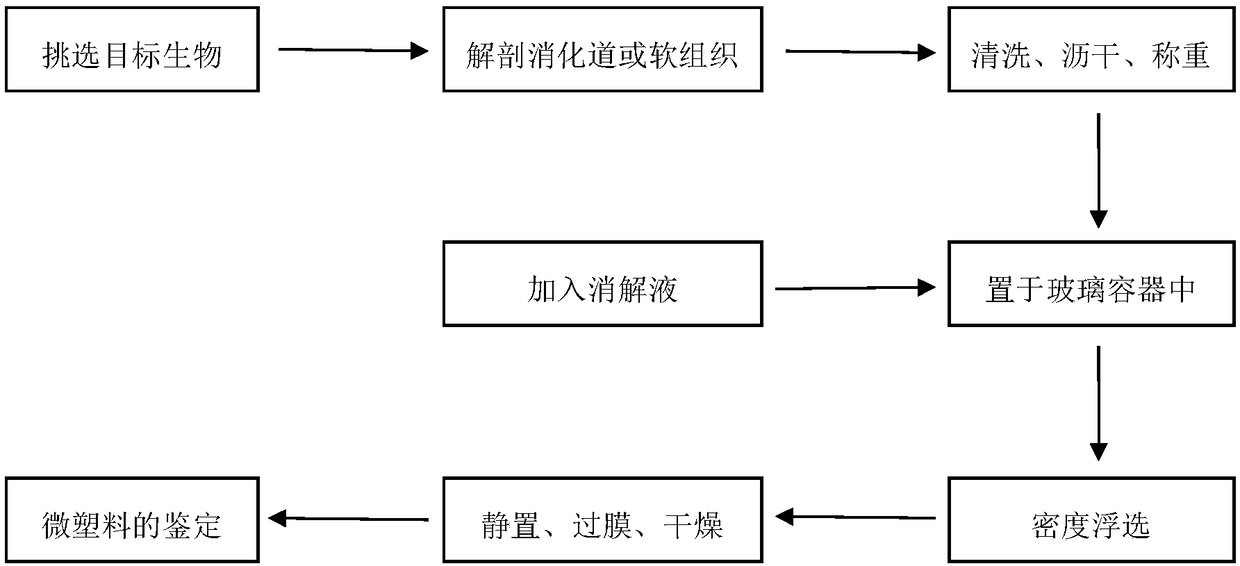Method for detecting density distribution of micro-plastics in soft tissues of marine organisms
A technology of marine organisms and density distribution, applied in the preparation of test samples, measuring devices, and analysis materials, etc., can solve the problems of high requirements for experimental conditions, low pretreatment and digestion rates, and damage to polymer structures. Reduce the effect of low risk factor, high digestion efficiency and improved accuracy
- Summary
- Abstract
- Description
- Claims
- Application Information
AI Technical Summary
Problems solved by technology
Method used
Image
Examples
Embodiment 1
[0060] (1) Select fish with similar biological individuals (see Table 1 for species), wash the digestive tract with pure water, drain the water, weigh and record the weight of the biological digestive tract;
[0061] (2) Put the drained digestive tract in a beaker, and add 30 mL of Fe with a concentration of 0.05 mol / L per 1 g of the digestive tract according to the weight of the biological digestive tract. 2+ solution, then add 30 mL of hydrogen peroxide solution with a mass fraction of 30%, and add in portions;
[0062] (3) Place the beaker on a magnetic stirrer for digestion at 60°C for 30 minutes until the digestion is complete to obtain a digestion mixture;
[0063] (4) Add 31.1g sodium chloride solid in every 100mL mixed liquor, carry out density flotation;
[0064] (5) Vacuum filter the flotation heavy liquid, pass through the membrane, and dry at room temperature for 24 hours. Through the microscope inspection of the filter, the suspected particles are picked for micr...
Embodiment 2
[0084] (1) Select bivalves with similar biological individuals (see Table 3 for species), wash the soft tissue with pure water, drain the water, weigh and record the weight of the biological soft tissue;
[0085] (2) Put the drained soft tissue in a beaker, add 30 mL of 0.1M Fe per 1 g of soft tissue according to the weight of the biological soft tissue 2+ solution, then add 30mL of hydrogen peroxide solution with a mass fraction of 32%, and add in portions;
[0086] (3) Place the beaker on a magnetic stirrer for digestion at 60°C for 30 minutes until the digestion is complete to obtain a digestion mixture;
[0087] (4) Add 31.1g sodium chloride solid in every 100mL mixed liquor, carry out density flotation;
[0088] (5) Vacuum filter the flotation heavy liquid, pass through the membrane, and dry at room temperature for 24 hours. Through the microscope inspection of the filter, the suspected particles are picked for microscopic-Fourier transform infrared spectroscopy and othe...
PUM
| Property | Measurement | Unit |
|---|---|---|
| Concentration | aaaaa | aaaaa |
| Aperture | aaaaa | aaaaa |
Abstract
Description
Claims
Application Information
 Login to View More
Login to View More - R&D
- Intellectual Property
- Life Sciences
- Materials
- Tech Scout
- Unparalleled Data Quality
- Higher Quality Content
- 60% Fewer Hallucinations
Browse by: Latest US Patents, China's latest patents, Technical Efficacy Thesaurus, Application Domain, Technology Topic, Popular Technical Reports.
© 2025 PatSnap. All rights reserved.Legal|Privacy policy|Modern Slavery Act Transparency Statement|Sitemap|About US| Contact US: help@patsnap.com



